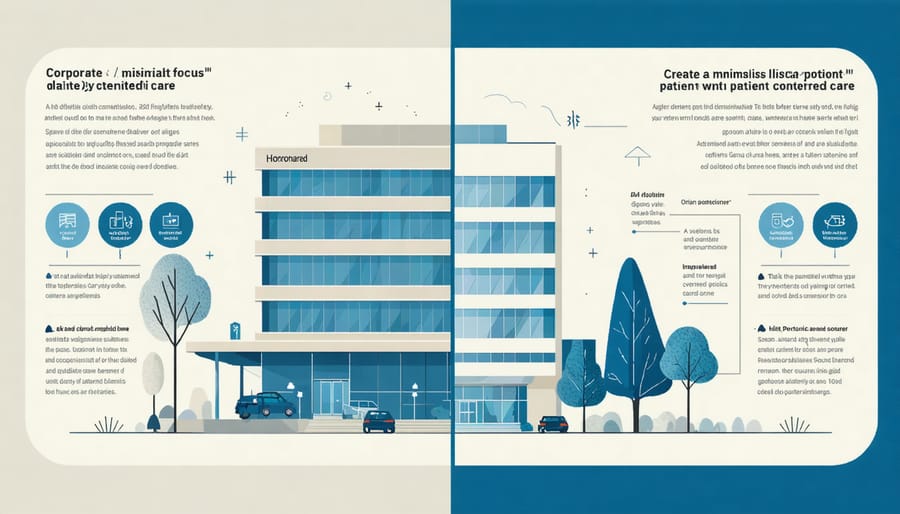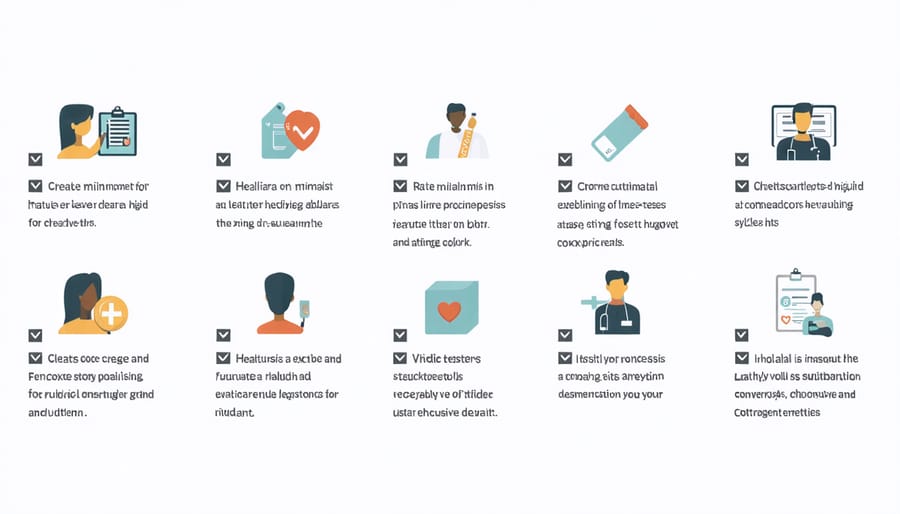When it comes to community health services, the distinction between for-profit and nonprofit systems profoundly impacts families’ access to care. Recent studies show that for-profit healthcare systems serve 35% of American communities, raising crucial questions about quality, accessibility, and cost of essential services.
The transformation of community hospitals from nonprofit to for-profit entities has sparked intense debate among healthcare professionals, policymakers, and families. While proponents argue that profit-driven models bring efficiency and innovation, critics point to concerning trends in reduced charity care, increased patient costs, and potentially compromised service quality, particularly in mental health and preventive care programs.
For parents navigating their children’s healthcare needs, understanding these systemic differences becomes essential for making informed decisions. Research indicates that nonprofit facilities typically reinvest 7.4% more of their revenue into community health programs compared to their for-profit counterparts, directly affecting the availability and quality of pediatric and mental health services in local communities.
This reality prompts us to examine how profit motives influence healthcare delivery, patient outcomes, and community wellbeing, especially for vulnerable populations requiring consistent, comprehensive care support.
Understanding For-Profit vs. Non-Profit Healthcare Models

Key Differences in Service Priorities
When it comes to healthcare priorities, for-profit and non-profit systems often take different approaches. For-profit healthcare systems typically focus on services that generate higher revenue, such as specialty procedures and elective surgeries. This can sometimes mean less emphasis on essential community programs like mental health services, preventive care, and education initiatives.
Dr. Sarah Martinez, a pediatric healthcare specialist, explains: “In my experience, non-profit systems are more likely to maintain services that might not be financially profitable but are crucial for community well-being, especially for children and families facing challenges.”
For-profit systems must balance shareholder interests with community needs, which can affect decisions about which services to offer and maintain. This might mean fewer resources for programs like school-based health services, community mental health outreach, or support groups for parents of children with special needs.
However, it’s important to note that many for-profit systems do work to maintain essential community services through partnerships with local organizations and innovative funding models. The key is understanding these differences when choosing healthcare providers for your family.
Financial Structure and Resource Allocation
In for-profit community health systems, funds are primarily distributed to benefit shareholders and support business growth, while also maintaining healthcare services. These organizations typically allocate 15-20% of their revenue toward profit margins and reinvestment opportunities. This can sometimes lead to prioritizing more profitable services over essential but less lucrative community health programs.
Non-profit systems, by contrast, reinvest all surplus funds back into community health initiatives, facility improvements, and expanded service offerings. They often maintain emergency funds and allocate resources based on community needs rather than profit potential. Many non-profit systems also receive support through grants, donations, and government funding, allowing them to offer sliding-scale fees and financial assistance programs.
Both models face challenges in balancing operational costs with quality care delivery. While for-profit systems might have better access to capital for technological upgrades and facility improvements, non-profit systems generally allocate a higher percentage of their budget directly to patient care and community outreach programs. Understanding these differences helps families make informed decisions about where to seek care while considering both quality and affordability.
Impact on Children’s Mental Health Services

Access to Care and Treatment Options
Access to mental health services in for-profit community health systems varies significantly across different locations and insurance coverage types. While some facilities offer comprehensive pediatric mental health care, others may have limited availability or higher out-of-pocket costs.
Dr. Sarah Martinez, a child psychiatrist with 15 years of experience, notes: “In for-profit systems, we often see a focus on services that generate higher revenue, which can sometimes result in longer wait times for mental health appointments or fewer specialized programs for children with complex needs.”
Families typically encounter different levels of accessibility:
– Insurance coverage may limit provider choices
– Some locations have extensive waiting lists
– Sliding scale payment options might be less common
– Treatment programs may be shorter in duration
– Follow-up care could be more restricted
However, many for-profit systems are working to improve access through:
– Telehealth services for routine appointments
– Partnerships with community organizations
– Financial assistance programs
– Extended evening and weekend hours
– Integration of mental health services with primary care
Parents should actively discuss payment options, insurance coverage, and treatment plans with providers to understand their full range of options and associated costs. Many facilities offer payment plans or can connect families with community resources for additional support.
Quality of Care Considerations
When examining how profit motives influence healthcare delivery, it’s important to understand both the benefits and challenges they present. For-profit community health systems often implement efficient management practices that can streamline services and reduce wait times. Many invest in modern technology and facilities, which can enhance the patient experience and treatment capabilities.
However, families should be aware that financial pressures can sometimes affect care decisions. Dr. Sarah Miller, a pediatric healthcare specialist, notes, “While many for-profit facilities provide excellent care, there’s often a delicate balance between meeting profit targets and delivering optimal patient outcomes.”
Quality metrics in for-profit systems typically focus on measurable outcomes and patient satisfaction scores. This approach can lead to improved service standards but might sometimes prioritize quick solutions over long-term health strategies. For instance, mental health treatment programs might be shortened to maximize patient turnover.
Parents have reported mixed experiences. Maria Thompson, whose daughter received mental health care at a for-profit facility, shares, “We received prompt attention and modern treatment options, but sometimes felt rushed through appointments.” This sentiment echoes a common observation that while efficiency is high, personal attention might be limited.
To ensure quality care in a for-profit setting, families should actively engage with healthcare providers, ask questions about treatment plans, and understand their options. Many successful for-profit systems maintain high standards through robust quality assurance programs and regular patient feedback mechanisms.
Community Support Programs: Changes and Challenges
Prevention vs. Treatment Focus
In for-profit community health systems, there’s often a noticeable emphasis on treatment over prevention, driven by the immediate revenue potential of acute care services. While treating existing conditions is essential, this approach can sometimes overshadow the long-term benefits of preventive care programs.
Dr. Sarah Chen, a pediatric healthcare consultant, notes, “When we invest in prevention, we see better outcomes for children and families, but these benefits may take years to materialize. For-profit systems sometimes struggle to prioritize these longer-term investments.”
Many parents report challenges in accessing preventive services like regular wellness checks, mental health screenings, and educational programs. Maria Rodriguez, a mother of three, shares, “Our local clinic focuses more on treating immediate issues. Getting appointments for preventive care often means longer wait times.”
However, some forward-thinking for-profit systems are beginning to recognize the value of prevention. They’re implementing innovative programs like school-based health initiatives and community wellness education, understanding that healthier communities ultimately lead to reduced healthcare costs and improved patient outcomes.
The key is finding a balance. While acute care remains crucial, community health systems must also invest in preventive measures to truly serve their communities’ long-term health needs.
Family Support Services
Under for-profit management, many communities have experienced significant changes in their family support services. While some facilities have maintained robust programs, others have seen reductions in services that families rely on, such as parenting classes, support groups, and child development resources.
Sarah Martinez, a community health coordinator in Tennessee, shares her experience: “We’ve noticed that programs focusing on prevention and early intervention are often the first to face budget constraints. These services are essential for families but may not generate immediate revenue.”
However, some for-profit systems have found innovative ways to sustain family programs through partnerships with local organizations and grant funding. For example, Central Health Systems in Ohio collaborates with local schools and churches to offer after-school programs and family counseling services at reduced costs.
Parents should be aware that service availability may vary significantly between facilities. It’s recommended to:
– Research available programs before choosing a healthcare provider
– Ask about sliding scale payment options
– Connect with local advocacy groups for support
– Explore alternative community resources when needed
– Stay informed about changes in service offerings
Understanding these changes helps families make informed decisions about their healthcare options and ensure continued access to vital support services.
Finding Quality Care in a For-Profit System

Questions to Ask Your Provider
When evaluating a Community Health Systems facility for your family’s care, consider asking these important questions during your consultation:
“What financial assistance programs are available for families?” Understanding payment options and sliding scale fees can help you plan for healthcare costs.
“How do you handle emergency mental health situations?” This is especially important if your child might need urgent care services.
“What is your staff turnover rate?” A stable healthcare team often indicates better continuity of care for your family.
“Do you offer integrated care services?” Ask about coordination between primary care, mental health, and specialty services under one roof.
“What are your quality metrics compared to non-profit hospitals in the area?” Request specific data about patient outcomes and satisfaction rates.
“How do you reinvest in community health programs?” Understanding their commitment to local health initiatives helps gauge their community focus.
“What is your policy on referring to specialists outside your network?” This affects your access to specialized care when needed.
“Do you offer telehealth services?” Virtual appointments can make healthcare more accessible for busy families.
“What support services do you provide for families?” Ask about social workers, patient advocates, and educational resources.
Remember to take notes during these conversations and trust your instincts about whether the facility aligns with your family’s needs and values.
Alternative Resources and Support
Beyond traditional healthcare systems, many communities offer valuable resources and support services that can complement or provide alternatives to for-profit care. Local health departments often provide free or sliding-scale services, including preventive care, vaccinations, and health screenings. Community health centers, which operate as non-profit organizations, focus on delivering affordable care regardless of ability to pay.
Faith-based organizations and charitable clinics frequently step in to fill healthcare gaps, offering basic medical services and mental health support. Many areas also have free clinics staffed by volunteer healthcare professionals, providing essential care to underserved populations.
For families seeking mental health support, community-based organizations often provide counseling services, support groups, and educational programs at reduced costs. School-based health centers can be excellent resources for children’s healthcare needs, while local universities with medical programs may offer reduced-cost care through teaching clinics.
Additionally, patient advocacy groups can help navigate healthcare options and negotiate medical bills. Online resources and telehealth services are becoming increasingly accessible, offering more affordable alternatives for routine care and consultations. Remember to explore state and federal assistance programs, which might provide coverage options for those who don’t qualify for traditional insurance but still need affordable healthcare access.
While Community Health Systems operates as a for-profit organization, this doesn’t mean we must choose between quality care and financial sustainability. The healthcare landscape continues to evolve, with many for-profit systems demonstrating their ability to provide excellent patient care while maintaining financial stability. Success stories from various communities show how these systems can reinvest profits into better facilities, advanced medical technology, and expanded mental health services.
The key is finding balance and holding healthcare providers accountable, regardless of their profit status. Families can advocate for better care by staying informed, participating in community health initiatives, and providing feedback to their local healthcare facilities. Many communities have successfully partnered with for-profit systems to ensure that essential services remain accessible to all residents, particularly in mental health and pediatric care.
Remember that healthcare delivery is ultimately about people helping people. Whether for-profit or non-profit, the most successful systems are those that prioritize patient outcomes and community wellbeing. By understanding how these systems work, staying engaged in local healthcare discussions, and advocating for quality care, we can help shape a healthcare future that serves everyone’s needs.
As we move forward, the focus should remain on creating collaborative partnerships between healthcare providers, community organizations, and families to ensure that all children and families have access to the care they need, when they need it.







